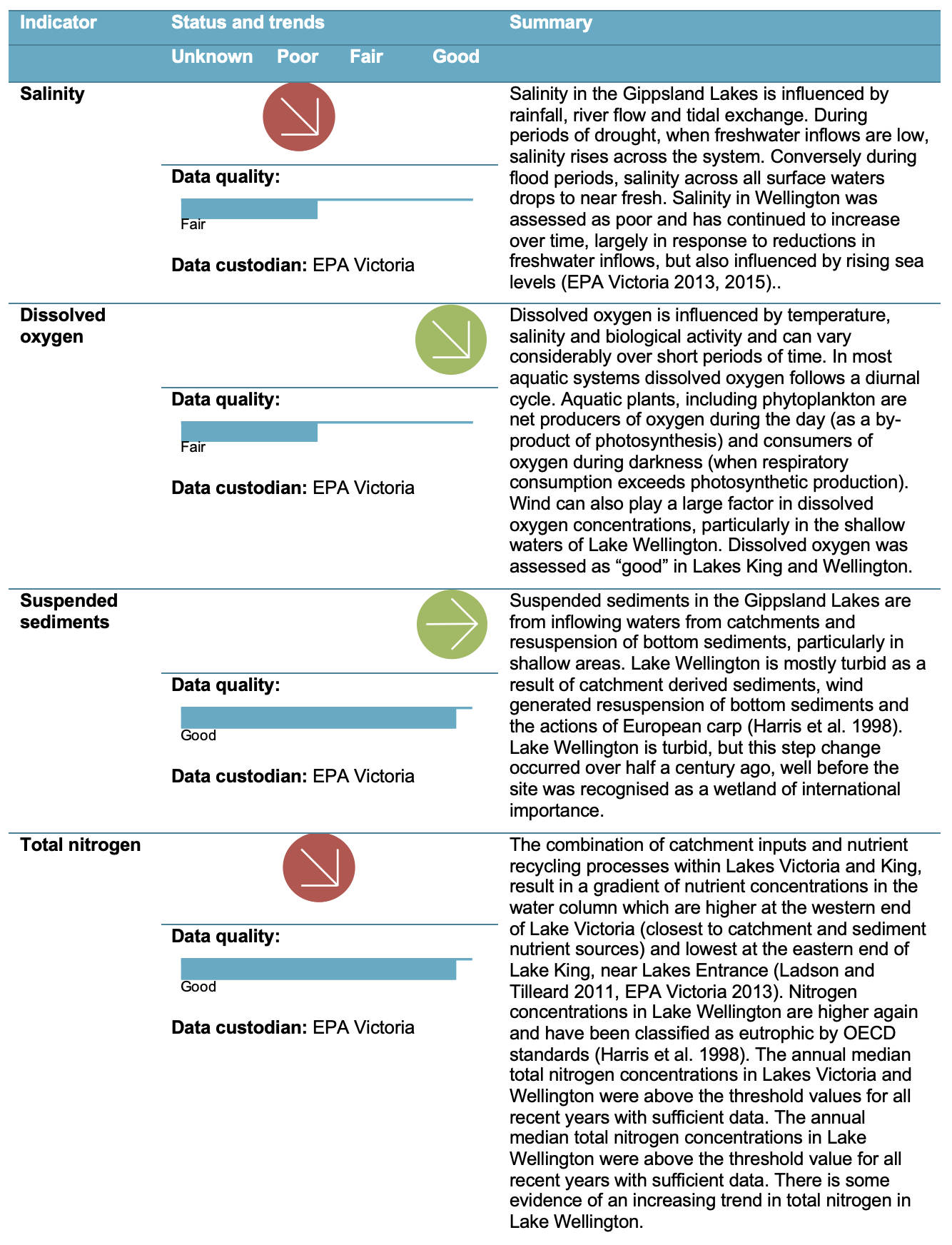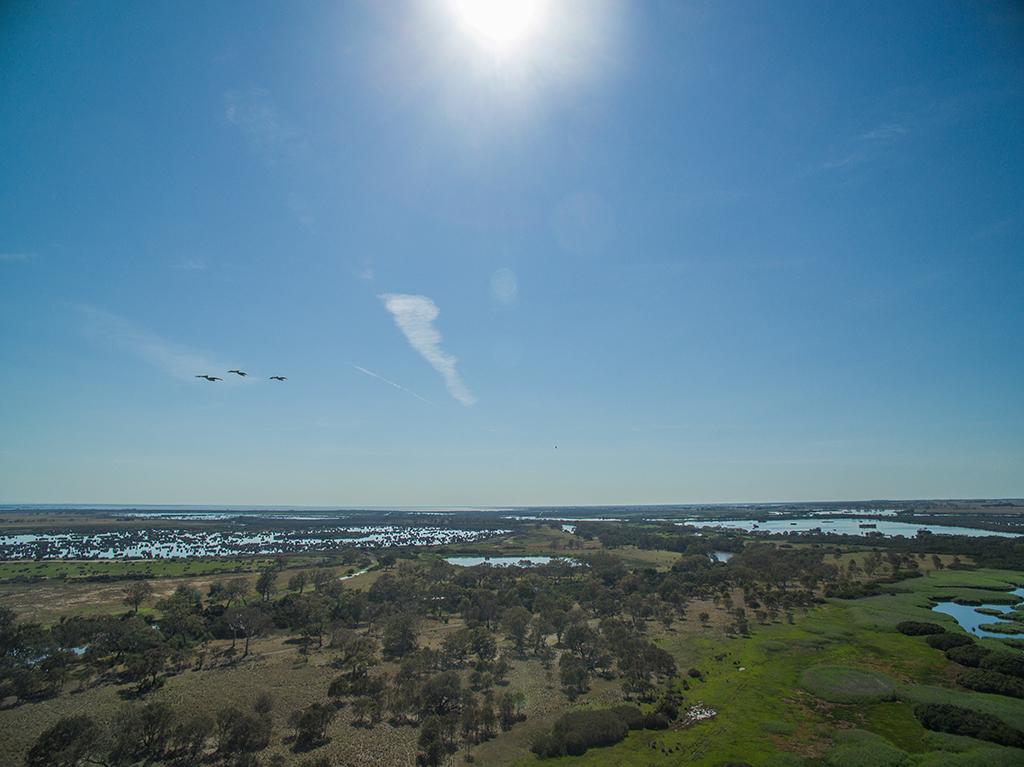
What do the results mean?
Water quality data is available for the main lakes (King, Victoria and Wellington) through EPA Victoria’s monitoring program. Results from the past five years have been compared to site specific objectives derived for the Gippsland Lakes using the national standard approach. Water quality across the lakes represents a gradient of relatively good water quality in Lake King, to poor water quality in Lakes Victoria and Wellington. Lake Wellington appears to be experiencing a sustained trend of increasing salinity.
There is some evidence of concentrations of mercury in sediments exceeding the sediment quality guideline low trigger values in Heart Morass, Lake Wellington and Lake Victoria. In addition, there are high concentrations of nickel throughout the system, although this is a result of underlying geology and common in aquatic ecosystems in Victoria. All other metals were below guideline levels and overall the risk to the environment and human health from toxicants in the Gippsland Lakes is considered to be low *.
Salinity in Dowd and Heart Morass is influenced by inundation and water source. Inflows of water from the Latrobe River result in reduced salinity, but when river flows are low, more saline water can enter the wetlands from Lake Wellington. Annual median salinity was below the threshold each year (2017/18 to 2020/21) with the exception of 2018/189 in Dowd Morass. This results in a rating of “good” for Heart Morass and “fair” for Dowd Morass. There is some evidence of decreasing salinity (improved condition) in recent years, but more data are required. Two new salinity meters have been established in Macleod Morass (May 2021) and a further two will be established in Sale Common, which will allow for water quality at these two freshwater wetlands to be evaluated in the future.
*Department of Health and Human Services (2017) Mercury levels in black bream and dusky flathead from the Gippsland Lakes, Victoria. State Government of Victoria, Melbourne, Victoria.
Reeves, J.M. and Trewarn, A. (2016) Assessment of Heavy Metals and Other Contaminants of the Gippsland Lakes. Federation University Australia, Mt Helen, Victoria.
Technical Reports
Case Study
Lake Wellington Changing Conditions
Local knowledge and scientific studies show that Lake Wellington was once characterised as clear water, fresh to brackish salinity, with extensive beds of submerged macrophytes (Vallisneria sp.) and fringing vegetation dominated by Common Reed (Phragmites australis). Now Lake Wellington is a turbid, phytoplankton dominated system with a lack of submerged vegetation and reduced fringing vegetation.
The change in conditions has been attributed to a number of factors and it is likely that all or at least several acted together (Ducker et al. 1977; Harris et al. 1998; Tilleard et al 2009; Boon et al. 2015):
Bushfires in 1965 followed by high rainfall resulting in large loads of nutrients and sediments entering the system.
The 1967/68 drought resulting in reduced water levels, high temperatures and death of submerged vegetation.
Increasing salinity and lowering of water levels as a result of the opening of the permanent entrance to the Southern Ocean.
Wind generated re-suspension of sediments and the actions of European carp resulting in sustained high turbidity and limiting the re-establishment of submerged macrophytes.
This transition from a clear water macrophyte dominated wetland to a turbid phytoplankton dominated system is termed “alternative stable states”. Alternative stable states is a respected ecological theory whereby a change in the environment can cause a shift in an ecosystem from one state to another (Beisner et al. 2003; Scheffer et al. 2001). That is, the new state which was created as a result of disturbance, is persistent.
The lesson learnt from over two decades of investigations into shifts across stable states is that the strong feedback loops inherent in any change makes it almost impossible to reverse, no matter what the scale of management intervention. That is, in this example, the shift to a turbid environment makes it impossible for submerged plants to establish as they are too light limited. Without the sediment stabilising effects of macrophytes, the sediment is highly mobile and is constantly re-suspended from the bottom by winds in the shallow lake system.
The Gippsland Lakes was recognised as a wetland of international importance under the Ramsar Convention in 1982, decades after the shift in state of Lake Wellington. Under the Convention, there is an obligation to maintain the ecological character of the site and the values they support. There is evidence that salinity in Lake Wellington is increasing and the impact of this on the ecological character of the Ramsar site is currently being investigated. In addition, the Ramsar Site Management Plan (DELWP 2015) has a commitment to setting realistic rehabilitation goals for Lake Wellington.




